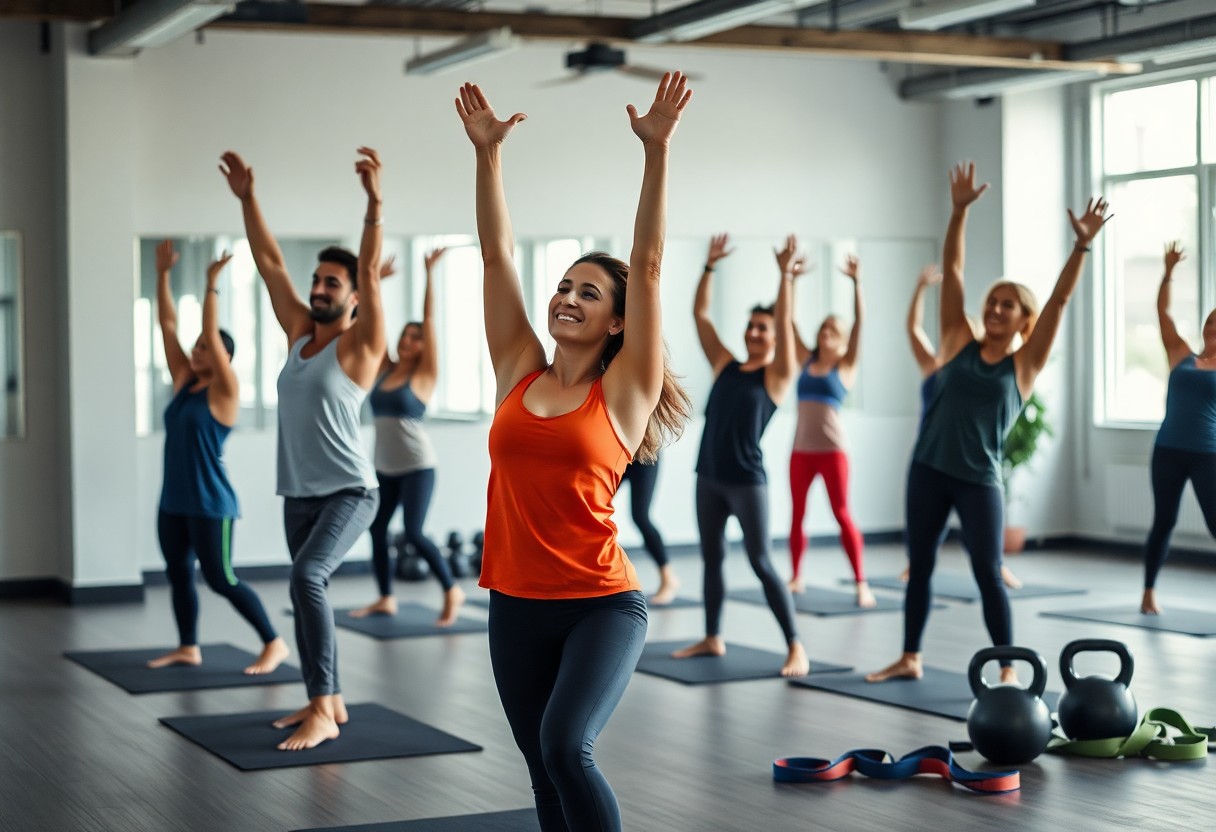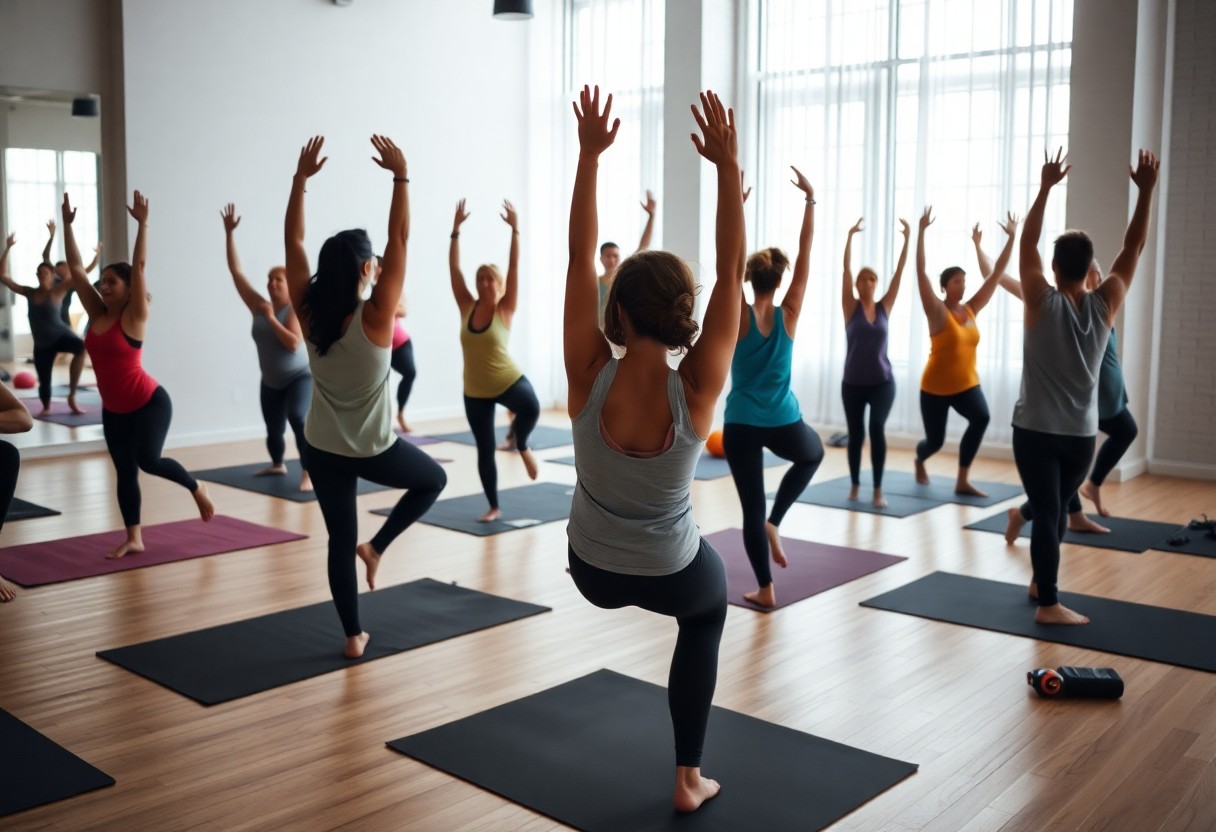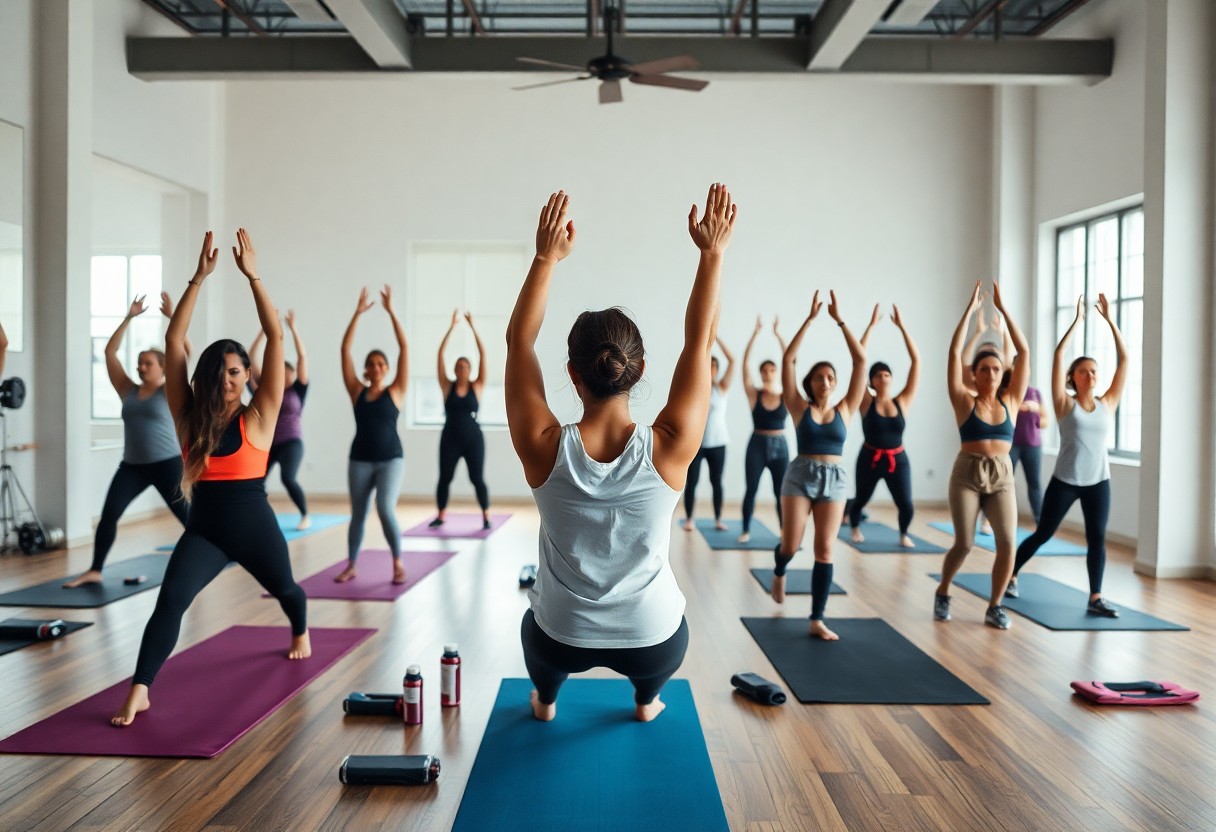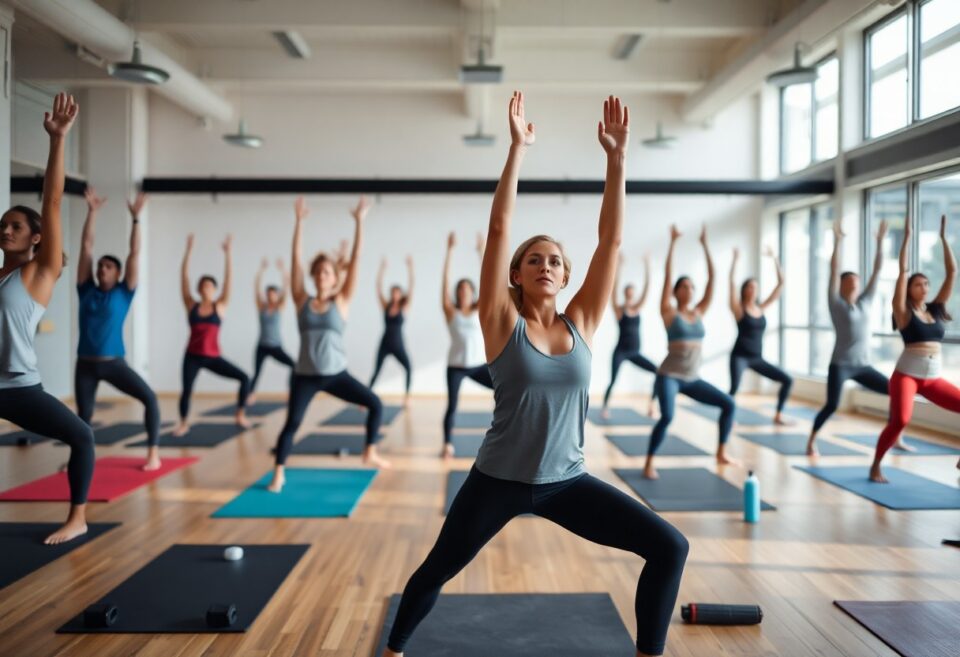HIIT combines intense bursts of exercise with short rest periods, and when fused with yoga, you unlock a powerful method to enhance both strength and flexibility. By integrating high-intensity interval training with mindful yoga poses, you optimize calorie burn and improve muscle endurance without sacrificing balance and breath control. This dynamic blend not only challenges your body but also helps prevent injury through mindful movement. If you want a workout that elevates your heart rate while deepening your mind-body connection, HIIT Yoga is an ideal solution to revolutionize your fitness routine.
The Synergy of HIIT and Yoga
By now, you’ve likely noticed how combining HIIT with yoga creates a fitness routine that is both demanding and deeply restorative. This synergy leverages the power of explosive cardio and strength movements alongside the fluidity and mindfulness inherent in yoga practice. The juxtaposition allows your body to develop endurance, flexibility, and balance, while your mind sharpens focus and remains grounded through each phase of your workout. Integrating these disciplines challenges your muscles to respond quickly, then recover with deliberate breath and controlled stretches, amplifying the efficiency of every session.
Understanding why this dynamic blend works involves recognizing how your energy systems interact during exercise. HIIT pushes your body into the anaerobic zone, leading to bursts of high intensity that stimulate muscle growth, improve metabolism, and burn calories long after the workout ends. Meanwhile, yoga emphasizes lengthening and mobilizing muscles, creating space that counteracts the tightness HIIT can produce. The postures promote not only physical recovery but also help regulate your nervous system, reducing stress hormones that might otherwise hinder muscle repair and overall well-being.
You’ll find that by alternating between explosive movement and mindful stretching, your performance in both areas improves. This cross-training environment prevents the plateaus often experienced with repetitive cardio or static yoga routines. It also significantly lowers the risk of injuries by encouraging muscular balance and enhancing joint stability. As these two practices complement each other, your fitness journey becomes more holistic, catering to strength, flexibility, endurance, and mental clarity simultaneously.
Unpacking the Benefits of High-Intensity Interval Training
High-Intensity Interval Training revolutionizes how you approach cardio by breaking workouts into short, intense spurts with recovery phases. This format elicits a powerful hormonal response, including increased secretion of growth hormone and adrenaline, which together amplify fat metabolism and muscle synthesis. Research indicates that HIIT protocols lasting just 15-20 minutes a few times a week can improve cardiovascular fitness as much as traditional longer-duration endurance training.
The versatility of HIIT means you can tailor exercises to your current fitness level while progressively challenging your limits. For example, incorporating plyometric moves like jump squats or mountain climbers not only engages fast-twitch muscle fibers but also improves neuromuscular coordination. As your heart rate soars and then drops during rest intervals, your body adapts by enhancing oxygen delivery and clearance of metabolic byproducts, which explains the rapid gains in your aerobic and anaerobic capacities.
Moreover, HIIT is a powerhouse for post-exercise oxygen consumption, commonly referred to as the “afterburn effect.” Your metabolism remains elevated up to 24 hours post-workout, facilitating sustained calorie burning without additional activity. This makes it highly effective for weight management and metabolic health, positioning HIIT as an efficient and time-smart strategy to elevate fitness without sacrificing your schedule.
Exploring the Mind-Body Connection in Yoga
Diving deeper into yoga reveals its profound impact on synchronizing your physical and mental realms. This mind-body connection is cultivated through deliberate breathing techniques (pranayama), focused attention (dharana), and the meditative aspect of flowing through asanas. Each pose demands not only muscular engagement but also awareness of alignment and internal sensation, prompting you to tune into subtle bodily cues. Such focused presence enhances proprioception, or your innate sense of where your body is in space, reducing injury risk and improving overall balance.
Yoga’s meditative elements activate the parasympathetic nervous system, promoting calmness and reducing the production of stress hormones like cortisol. This physiological shift supports recovery processes and mitigates fatigue accumulated during intense HIIT bursts. As your practice deepens, the integration of mindful movement and breath fosters mental resilience, allowing you to approach physical challenges with increased patience and less reactive tension, optimizing both performance and recovery.
The sustained emphasis on breath control during yoga also enhances your respiratory efficiency, which proves invaluable during high-intensity exercises. Improved oxygen uptake and carbon dioxide elimination can delay the onset of muscle fatigue during sprints or explosive movements, enabling you to maintain higher power output. Furthermore, the calming practice of yoga counters the overstimulation often triggered by HIIT, creating a balanced nervous system response that enhances overall well-being.
Understanding these interwoven aspects of yoga encourages you to view your practice as more than just physical exercise. It is a tool to cultivate emotional balance, focus, and mental clarity that reverberate beyond the mat into your everyday life, enriching your workout effectiveness and personal resilience.

Crafting Your HIIT Yoga Routine
Developing a balanced HIIT yoga routine revolves around strategic sequencing and timing. You’ll want to intersperse vigorous, high-intensity intervals with mindful, controlled yoga flows that aid recovery while maintaining engagement. For instance, structuring your workout into cycles of 30 seconds of explosive cardio moves followed by 45-second yoga poses can keep your heart rate elevated while preventing burnout. Most effective routines span 20 to 30 minutes, including a warm-up and cooldown, allowing you to maximize calorie burn without overtaxing your muscles. Experimenting with interval lengths and rest periods will help you fine-tune the intensity to match your fitness level.
To maintain motivation and continually challenge yourself, varying the types of exercises within each session can prevent plateaus. You might begin with plyometric-focused HIIT sequences such as jump squats or mountain climbers, then transition into yoga postures emphasizing strength and flexibility like Warrior II or Downward Dog. The fluidity between rapid movement and deliberate stretching not only improves cardiovascular fitness but also enhances muscular endurance and joint mobility. Layering progressions over time by increasing the number of rounds or extending the high-intensity intervals fosters continual growth in your strength and stamina.
Consistency plays a powerful role in the results you achieve through HIIT yoga, but rest and recovery shouldn’t be sidelined. Scheduling at least two or three sessions per week provides ample stimulus for improvement while allowing your body to adapt. Post-workout, incorporating static stretches and breathing exercises accelerates muscle repair and mental relaxation. Tracking your performance metrics, such as interval times, heart rate variability, and perceived exertion, offers objective feedback to modify your routines and push your boundaries safely and effectively.
Essential HIIT Elements to Incorporate
Fundamental to your routine are the pillars of HIIT: bursts of maximum effort followed by precise recovery periods. Selecting exercises that engage large muscle groups while elevating your heart rate quickly ensures efficiency in calorie burn. Moves like burpees, high knees, and jumping lunges serve as excellent choices to kickstart your cardiovascular system and prepare muscles for the yoga sequences that follow. Adjust intensity by modulating speed, explosiveness, and range of motion, ensuring each interval challenges your anaerobic threshold.
The timing structure holds equal weight in sculpting a potent session. Protocols such as 40 seconds on with 20 seconds off, or 30 seconds on followed by 30 seconds rest, can be tailored to your current conditioning. Using a timer app or interval bells helps you maintain discipline and consistency between work and rest phases.
During rest intervals, integrating gentle yoga postures like Child’s Pose or Cat-Cow allows your breathing to regulate and muscles to elongate without fully stopping movement. These active recoveries facilitate lactate clearance and reduce perceived exertion, keeping your performance sharp throughout the workout.
Moreover, incorporating multi-planar movement into your HIIT exercises enriches functional fitness. Rotational lunges, skater jumps, and plank variations engage different muscle groups and improve coordination. Blending these dynamic exercises with yoga’s static holds enhances neuromuscular control, which can translate into improved sport-specific performance and injury prevention. Paying attention to form during these explosive movements prevents compensations and maximizes the efficiency of each exercise.
Yoga Poses That Amplify Intensity
Introducing more demanding yoga poses within your HIIT framework can significantly elevate the workout’s intensity while fostering strength and balance. Postures like Crow Pose (Bakasana) and Side Plank (Vasisthasana) require substantial core engagement and upper body strength, aligning well with the high energy expenditure from HIIT intervals. Incorporating these into your active recovery phases transitions your body seamlessly from power-driven bursts to controlled, strength-building holds.
The challenge heightens when integrating dynamic yoga flows such as Vinyasa sequences performed at a brisk pace between intervals. Sun Salutations (Surya Namaskar) done rapidly increase heart rate similarly to cardio but engage flexibility and breath control. This dual function not only sustains elevated metabolic rates but also cultivates mental focus—a hallmark benefit of yoga practice. Within these flows, emphasizing precise alignment in poses like Warrior III or Chair Pose synergizes muscular endurance with cardiovascular load, maximizing overall calorie burn.
Tactically employing balance-intensive asanas, including Tree Pose (Vrksasana) or Half Moon Pose (Ardha Chandrasana), disrupts your proprioceptive comfort zone. The subtle engagement of stabilizing muscles during these poses complements the explosive strength acquired from HIIT intervals. Such integration improves postural stability and muscle coordination, which can reduce compensation injuries post-exercise. Progressively extending hold times or incorporating arm and leg lifts can further amplify difficulty and training effectiveness.
These yoga poses function beyond static postures; their inclusion in your HIIT yoga routine amplifies every session’s overall intensity while simultaneously honing your mindfulness and breath control. This balancing act between explosive movement and focused stillness lies at the heart of HIIT yoga’s transformative potential.

Timing and Frequency: Finding Your Balance
Optimal HIIT Yoga Schedule for Maximum Results
Balancing the intensity of HIIT with the mindfulness of yoga means structuring your workouts thoughtfully to maximize benefits. Aim for about three to four HIIT yoga sessions per week to allow your body to experience the high-energy intervals while also benefiting from adequate recovery and flexibility work. For example, you might schedule your sessions on Monday, Wednesday, Friday, and perhaps Sunday, giving you alternating rest or low-impact days that promote muscle repair and prevent burnout.
Each session should ideally last between 30 to 45 minutes, mixing bursts of explosive movements like jump squats or mountain climbers with slower, controlled yoga poses such as Warrior II or Downward Dog. The combination ensures that you build cardiovascular strength and endurance without sacrificing balance, flexibility, or mindfulness. By consistently following this schedule, your body adapts to the physical demands, leading to improved performance and reduced injury risk.
Consistency is key, but allowing enough time for recovery between sessions optimizes muscle repair and neural adaptation. Integrating active recovery days—like gentle yoga, walking, or swimming—into your week supports this process by increasing blood flow without overloading your system. Monitoring how your body responds on both training and rest days guides you in refining your schedule, ensuring your HIIT yoga workouts align with your personal fitness goals.
Signs Your Body Needs a Break
You might notice a persistent level of fatigue that doesn’t dissipate after a good night’s sleep—this is a common warning sign that your body is in need of rest. Experiencing frequent muscle soreness or joint pain beyond the typical delayed onset muscle soreness (DOMS) signals that recovery is lagging, increasing your risk for injury. Additionally, a sudden drop in workout performance or motivation can reflect underlying overtraining and stress, making breaks vital for long-term progress.
Sleep patterns also offer vital clues; if you’re struggling to fall asleep or waking frequently, the accumulated physical and mental stress from intense HIIT yoga sessions might be disrupting your rest cycle. Mood fluctuations, irritability, or increased anxiety can accompany overtraining, indicating that your nervous system requires downtime. By tuning into these signs, you can adjust your routine proactively to avoid setbacks.
Moreover, your immune response provides subtle feedback—catching colds more often or feeling generally run-down suggests your body’s defenses are compromised. Ignoring these red flags prolongs recovery and may lead to chronic fatigue or injury. Scheduling designated rest days, incorporating restorative yoga sequences, or even taking a full week off from intense training can help restore your energy and maintain long-term progress.
Being attentive to these physical and emotional signals helps you strike a sustainable balance in your HIIT yoga practice. Prioritizing rest when necessary enhances your performance, prevents injury, and keeps your workout journey enjoyable and effective over time.

Equipment and Space: Setting Up for Success
Must-Have Gear for HIIT Yoga Enthusiasts
HIIT Yoga demands a mix of durability and flexibility from your equipment, blending high-impact cardio with deep, sustained stretches. Your yoga mat serves as the foundational gear but selecting one with added thickness (typically 5-6mm) supports cushioning during jumps and protects your joints. Opt for mats made from natural rubber or TPE for optimal grip and eco-friendliness. Since your hands and feet will often be sweaty from intense exertion, a non-slip surface is vital to prevent injuries and maintain stability throughout poses.
Besides your mat, resistance bands and light dumbbells can amplify your HIIT Yoga sessions by adding strength components without overwhelming your flow. Resistance bands ranging from 10-30 lbs tension help tone muscles during warrior transitions or lunges, while dumbbells (3-8 lbs) can increase your metabolic output during rapid sequences. For balance and core engagement, a small yoga block or balance cushion challenges proprioception and can deepen postural control during transitions.
Hydration gear and a sweat-absorbing towel cannot be overlooked given the intensity of your workout. A spill-proof water bottle should be accessible to replenish fluids swiftly during breaks, while microfiber towels wick moisture efficiently to keep your grip firm. Investing in moisture-wicking workout clothes tailored for both breathability and flexibility ensures your movements remain uninhibited while managing heat and sweat.
Transforming Any Space into a Dynamic Workout Environment
Converting your personal space into an effective HIIT Yoga studio revolves around optimizing both comfort and functionality. In confined areas, consider vertical storage solutions like wall-mounted racks or hooks to keep equipment organized and accessible without clutter. Mirrors can be strategically placed to help you self-correct alignment during intricate poses, boosting both form and confidence. Adequate ventilation or a quiet fan helps maintain an invigorating environment, reducing overheating and keeping fresh air circulating.
Lighting plays an underappreciated role in invigorating your practice space. Natural daylight energizes and aligns your circadian rhythm, so positioning your yoga area near windows enhances alertness and mood. When natural light is limited, adjustable LED lighting with dimming options can mimic different times of day, supporting either the high-intensity bursts or calming cooldown periods. Additionally, noise-cancelling headphones or ambient sound machines can create an immersive experience, boosting focus and blocking external distractions.
Flooring is another significant factor; hardwood or laminate floors provide the perfect blend of firmness and support for HIIT Yoga’s transitions. If your space has carpet, layering with a thick mat or interlocking foam tiles prevents slipping and adds shock absorption during jumps and landings. Decluttering the environment encourages mental clarity, and adding a small plant or two can increase oxygen levels and impart a sense of calm, balancing the intensity of your workout.
For those adapting multi-purpose rooms, flexibility is key—keep your gear portable and your space easily rearranged. For example, rolling up your mat and storing your weights in a closet post-workout allows immediate conversion back to a living area. You can also use foldable storage benches that double as seating and equipment holders. A wireless speaker provides clear, motivating music that can transform the energy of any room, while smart home devices can automate lighting and airflow to set the perfect ambiance without interrupting your flow.
Nutrition and Recovery: Fueling Your Performance
Pre-Workout Nutrition Strategies for HIIT Yoga
Engaging in HIIT Yoga requires you to strike a delicate balance between energy availability and digestion comfort. Opt for a meal or snack that is light and rich in complex carbohydrates such as oatmeal, a banana, or whole-grain toast about 60 to 90 minutes before your session. This timing ensures your body has enough glucose to power through the high-intensity intervals while preventing any sluggishness or gastrointestinal discomfort caused by heavy meals. A combination of carbohydrates and a moderate amount of protein — think a small serving of Greek yogurt or a scoop of nut butter — helps sustain energy levels and supports muscle resilience.
Hydration cannot be overlooked. About 20 minutes before your HIIT Yoga workout, sip on water or an electrolyte-infused drink to maintain optimal fluid balance. Exercising in this hybrid format, which often includes vigorous cardio alongside yoga poses, can accelerate fluid loss through sweating, leading to decreased performance and endurance if not addressed. You may also consider adding a small amount of caffeine through options like black coffee or green tea to increase alertness and enhance fat oxidation during your workout, as studies have shown caffeine can improve both aerobic and anaerobic exercise capacity.
If you plan to train early in the morning or after a long fasting period, a quick easily digestible snack such as a smoothie made with banana, a handful of spinach, and whey protein can jumpstart your metabolism and provide immediate energy. Avoid high-fat or high-fiber foods immediately pre-workout, as they can slow digestion and cause discomfort during the dynamic movements of HIIT Yoga. Personal experimentation with timing and food choices will help you find exactly what fuels your performance best while maintaining comfort throughout the session.
Post-Workout Recovery Techniques to Enhance Gains
After a demanding HIIT Yoga session, replenishing your body becomes necessary to enhance muscle repair and restore energy reserves. Within 30 minutes post-exercise, consuming a combination of carbohydrates and proteins facilitates glycogen restoration and stimulates muscle protein synthesis. A ratio near 3:1 or 4:1 of carbs to protein works well; for example, you could enjoy a smoothie blending sweet potato, a scoop of whey or plant protein, and a splash of almond milk or a balanced meal like brown rice with grilled chicken and steamed vegetables. This nutritional approach helps reduce muscle soreness and accelerates recovery.
Active recovery techniques can dramatically improve your readiness for subsequent workouts. Incorporate light yoga flows, deep stretching, or low-intensity walking on rest days to boost circulation and encourage the removal of metabolic waste products like lactic acid. Temperature-based therapies such as contrast baths—alternating between cold and warm water immersion—also stimulate blood flow and reduce muscle inflammation. Foam rolling and use of massage balls or professional myofascial release sessions ease tightness, improve tissue quality, and help maintain mobility crucial for yoga practice.
Beyond nutrition and physical recovery methods, quality sleep stands as a pillar of muscle regeneration and cognitive restoration. HIIT Yoga places considerable demand on your nervous system, so maintaining consistent sleep patterns with 7 to 9 hours per night supports hormonal balance, particularly growth hormone release, which aids tissue repair. Incorporating relaxation routines with gentle breathing exercises or meditation can promote faster sleep onset and improve overall restfulness, allowing your body and mind to fully recuperate for future sessions.
The intersection of targeted nutrition, active recovery, and restorative practices unlocks your full potential in HIIT Yoga. By tailoring your post-workout strategy to incorporate nutrient timing, movement, and rest, you ensure continual progress and minimize injury risk. The synergy between these elements creates a foundation upon which your strength, flexibility, and endurance will thrive—fueling not only your immediate performance but also your long-term wellness journey.
Final Words
On the whole, embracing HIIT Yoga is a transformative step toward elevating your fitness routine and achieving a more comprehensive workout experience. By integrating the intense cardiovascular bursts of High-Intensity Interval Training with the mindful, strength-building elements of yoga, you engage both your body and mind in a powerful synergy. This combination not only enhances your endurance and flexibility but also sharpens your focus and breath control, creating a holistic approach to health that supports physical and mental well-being.
When you incorporate HIIT Yoga into your schedule, you maximize your workout efficiency, allowing you to gain significant benefits in less time compared to traditional exercise methods. The alternating periods of high intensity and controlled yoga postures challenge your muscles and cardiovascular system while promoting recovery and balance. This dynamic blend encourages you to push your limits safely, while maintaining alignment and proper form, which helps reduce the risk of injury and supports long-term progress in your fitness journey.
Ultimately, your commitment to exploring and consistently practicing HIIT Yoga unlocks a wide range of advantages that extend beyond typical workout outcomes. You cultivate resilience, improve your metabolic rate, and foster a deeper connection between your body and breath. Whether you are seeking weight management, increased stamina, or enhanced mental clarity, this innovative approach equips you with the tools to reach your goals effectively. By making HIIT Yoga a regular part of your life, you invest in your overall vitality and set the stage for lasting health improvements.
FAQ
Q: What is HIIT Yoga and how does it differ from traditional yoga?
A: HIIT Yoga is a fusion workout combining High-Intensity Interval Training (HIIT) with yoga. It alternates between short bursts of intense exercise and yoga poses, enhancing cardiovascular fitness while improving flexibility and mindfulness. Unlike traditional yoga, which often focuses on steady, flowing movements and relaxation, HIIT Yoga incorporates rapid, challenging intervals to maximize calorie burn and endurance.
Q: Who can benefit from practicing HIIT Yoga?
A: HIIT Yoga is suitable for individuals looking to improve both their strength and flexibility in a time-efficient manner. It appeals to those who enjoy dynamic workouts and want to combine cardiovascular conditioning with mindful movement. Beginners can modify the intensity and duration of intervals, while experienced practitioners can increase challenge to fit their fitness level.
Q: How does HIIT Yoga improve overall fitness?
A: This blend enhances cardiovascular health through high-intensity intervals, builds muscular strength and endurance from yoga postures, and aids in flexibility and balance. Additionally, the integration of breathing techniques promotes mental focus and stress management, making it a comprehensive approach to physical and mental well-being.
Q: What equipment is needed for a HIIT Yoga workout?
A: Minimal equipment is required. A yoga mat provides comfort and grip during poses, and optional items like yoga blocks or straps can assist with alignment and modifications. Comfortable workout attire and a timer or interval app are helpful to keep track of work and rest periods during the HIIT segments.
Q: How can beginners safely start with HIIT Yoga?
A: Beginners should start with shorter intervals and lower intensity to allow the body to adapt. Focusing on proper form during both the yoga poses and high-intensity movements reduces injury risk. It is advisable to follow guided classes or videos designed for beginners and gradually increase duration and intensity over time.
Q: How often should HIIT Yoga be practiced for optimal results?
A: Practicing HIIT Yoga 2 to 4 times per week can provide significant improvements in fitness. Incorporating rest days or lower-intensity workouts in between ensures adequate recovery. Consistency paired with listening to your body’s needs will help maximize benefits while preventing overtraining.
Q: Can HIIT Yoga aid in weight loss?
A: Yes, the combination of high-intensity intervals with strength-building yoga poses increases calorie expenditure and boosts metabolism. This dynamic approach can contribute to fat loss when paired with a balanced diet and regular physical activity. Additionally, the mindfulness aspect of yoga may support healthier lifestyle choices overall.
